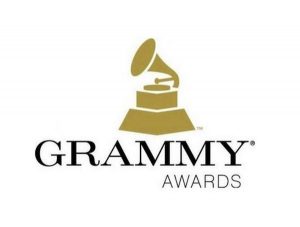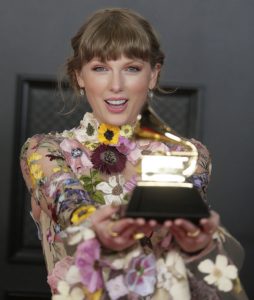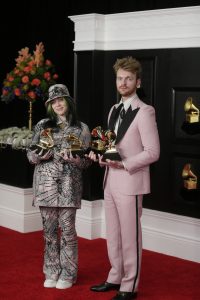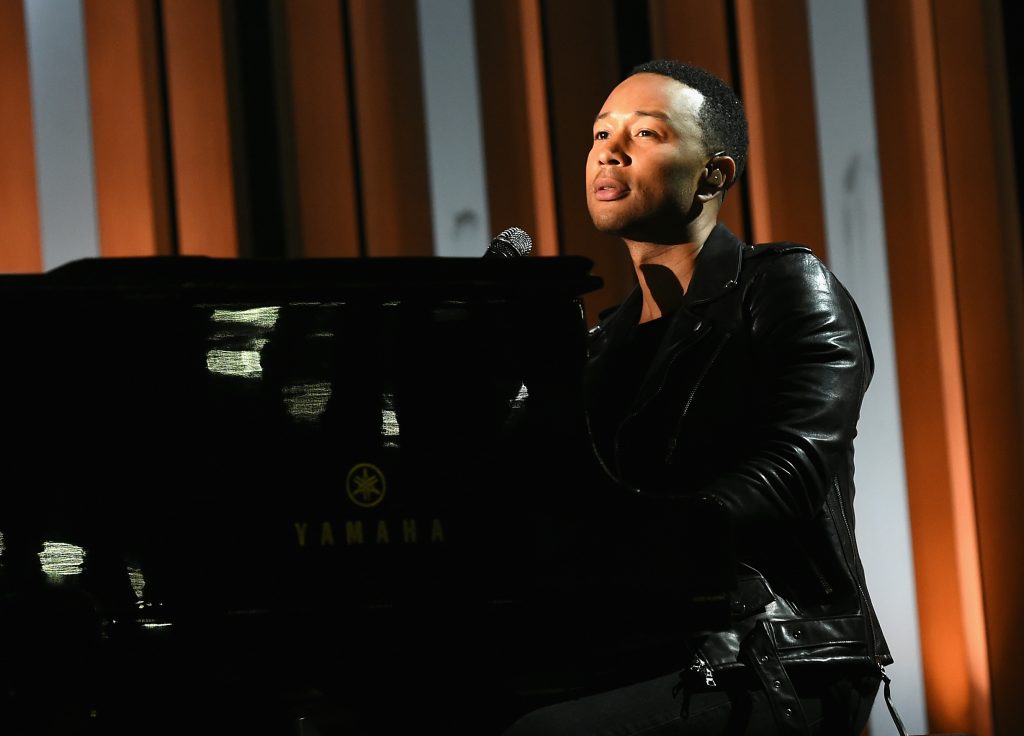November 24, 2021
by Carla Hay

Directed by Paul Thomas Anderson
Culture Representation: Taking place in 1973 in California’s San Fernando Valley, the comedy/drama “Licorice Pizza” features a predominantly white cast of characters (with a few African Americans, Asians and Latinos) representing the working-class, middle-class and wealthy.
Culture Clash: A 15-year-old boy and a 25-year-old woman become unlikely business partners and friends, while she has conflicting feelings about his desire to be more than friends with her.
Culture Audience: “Licorice Pizza” will appeal primarily to people who are fans of filmmaker Paul Thomas Anderson and movies set in the 1970s with a quirky but emotion-driven storyline.
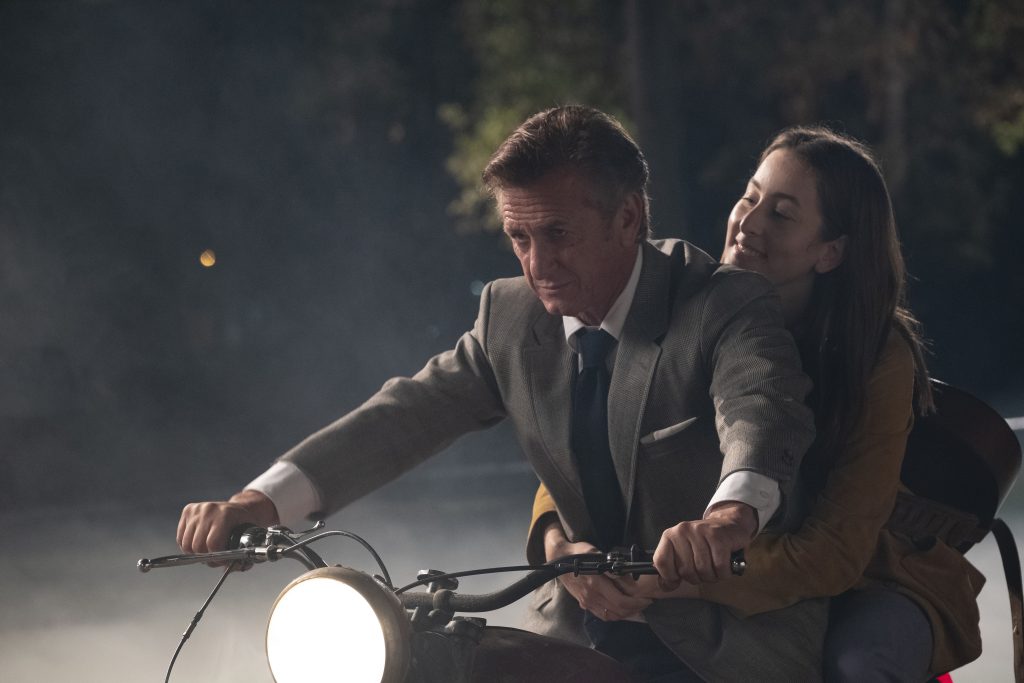
The rollicking and occasionally far-fetched dramedy “Licorice Pizza” tests the boundaries of if it’s appropriate to celebrate that a 15-year-old boy wants to seduce a 25-year-old woman. The movie doesn’t waste time with this story concept because it’s delivered in a very “only in a movie” way in the film’s opening scene, where characters who are supposed to be total strangers immediately and unrealistically exchange snappy banter that sounds exactly like what it is: well-rehearsed dialogue. This over-familiarity between strangers sets the tone for much of what happens in “Licorice Pizza,” which writer/director/producer Paul Thomas Anderson presents as a version of a heightened reality.
Any controversy about underage teen sexuality is avoided because there’s no sex in the movie, but there is a lot of adult language about sex and sexuality. “Licorice Pizza” (which is set in 1973, in California’s San Fernando Valley) is a movie were viewers will have to suspend some disbelief. That’s because a great deal of the story is about how this same “lovestruck” teenager is able to go from being a socially awkward student to being a confident and hustling business owner in the space of what seems to be a few short months.
“Licorice Pizza” is also a movie that is supposed to make some viewers uncomfortable, as well as make viewers laugh at the unpredictable comedy, feel tearkerking empathy during some of the drama depicting unpleasant realities, and get heartwarming joy from some of the romantic scenes. This is Anderson’s filmmaking style. People who watch his movies probably know it already. Anderson’s screenplays aren’t always perfect or consistently believable, but he casts his movies with talented actors who give memorable performances. Even the worst of Anderson’s movies have scenes and acting that people will remember.
“Licorice Pizza” mostly triumphs because of the cast members’ performances and when the movie is about the comedy that can be found in human flaws and quirks. “Licorice Pizza” tends to be less charming when it seems to both ridicule and embrace certain tropes in romantic movies. You can’t really have it both ways in the same film, and if you try to do that, it just makes filmmaking choices look wishy-washy or confused.
For example, there’s a recurring emphasis on the would-be “Licorice Pizza” couple—15-year-old Gary Valentine (played Cooper Hoffman) and 25-year-old Alana Kane (played by Alana Haim)—having scenes where one is running toward the other. They run either to help the other in a moment of distress; they run together while holding hands; or they run to indicate, “I’m so happy to see you that I can’t wait to hug you!”
These running scenes (some of which happen very abruptly) seem to be a spoof on clichés that are over-used in sappy romantic movies, as if this would-be couple might suddenly begin singing too. But there are moments when “Licorice Pizza” earnestly wants these running scenes to be taken seriously, in order to tug at viewers’ heartstrings. It’s this somewhat off-kilter tone that might be a turnoff to some viewers, but other viewers might think it’s compelling.
“Licorice Pizza” has some subtle and not-so-subtle commentary on the rigid gender roles that affect people’s perceptions of who should be the pursuers when it comes romance and sex. After all, reactions to “Licorice Pizza” would probably be very different if the movie had been about a 15-year-old girl who wants to date a 25-year-old man. “Licorice Pizza” certainly isn’t the first movie to be about an underage teenager who “falls in love” with an adult. But it’s impossible not to notice that a lot of what Gary gets away with would not be allowed for a female character of the same age, even if the movie were set in the present day.
It’s more of a commentary on sexism in society than Anderson’s personal filmmaking choices. However, “Licorice Pizza” still clings to the old-fashioned teen movie tropes of a nerdy teenage guy pining over a love interest and all the things he does to try to impress this love interest. It automatically sets up the teenage boy as the underdog. Movies like this almost never have an unhappy ending. The main difference between “Licorice Pizza” and most of the other teen-oriented movies that follow this over-used formula is that Anderson comes up with much better dialogue and more interesting characters portrayed by skillfull cast members. These are all the saving graces of “Licorice Pizza.”
Gary is a mix of insecurity and bravado when it comes to how he’s going to win over Alana, as well as how he becomes an aspiring business mogul. In the movie’s opening scene, it’s yearbook portrait day at Gary’s high school. Alana is an assistant at the photography studio that’s doing the student portraits on the school’s campus. The photo studio is called Tiny Toes, which implies that its specialty is doing children’s photography.
Gary is standing in a line outside the school to get his photo taken. He first sees Alana, looking bored, as she walks past the queuing students to offer a comb and mirror to anyone who needs these items. People mostly ignore Alana, except for Gary, who seems to have a “love at first sight” moment and tells Alana that he wants to use a comb and mirror.
Gary doesn’t waste time in letting Alana know that he’s interested in her. He immediately asks Alana out on a dinner date. She essentially laughs in his face and tells him, “You’re 12 … How are you going to pay?” Gary proudly tells Alana that he’s actually 15 (as if that makes a difference in his underage status) and he earns money by being an actor.
He starts listing his acting credits, which are mostly in commercials or bit parts in TV shows. However, Gary has his biggest role so far as a supporting actor in a movie musical called “Under One Roof,” in which he plays one of several orphans in an orphanage. It’s this movie role that ends up being a catalyst for how Gary and Alana’s relationship develops.
Alana bluntly tells Gary that it would be illegal for her to date him, but Gary is undeterred. He replies, “You give me hope. This is fate that brought us together!” Who talks like that to someone they just met? Alana gives a more realistic reply: “I doubt it, but we’ll see.” During this first conversation, Gary and Alana find out that she lives in Encino, while he lives in Sherman Oaks, which are about six miles apart from each other.
Alana still refuses Gary’s invitation for a dinner date. She thinks it’s somewhat amusing that this teenager is ardently pursuing her after they just met. “Don’t call it a date,” Gary says in an effort to convince Alana to meet him at his favorite local restaurant, which is called Tail o’ the Cock. (Cue the double entendre jokes.) Gary tells Alana that all he wants is for her to “just come by and say hello.”
Gary has a brother named Greg (played by Milo Herschlag), who’s about 8 or 9 years old. Gary often has the responsibility to look after himself and Greg because their single mother Anita (played by Mary Elizabeth Ellis), who’s an independent publicist, frequently has to travel away from home because of her job. (Gary’s father is not seen or mentioned in the movie.) At the time that Gary and Alana have met, Anita is temporarily in Las Vegas to do public-relations work for a hotel.
After school that day, Gary excitedly tells Greg, “I met the girl I’m going to marry one day!” Gary rushes to get ready for his “date” with Alana. There’s no guarantee that she’ll show up at the restaurant, but Gary is still hopeful. And sure enough, Alana shows up, with an expression on her face that seems to say, “I can’t believe I’m actually doing this.”
Gary is so elated and smitten that he intensely stares at Alana when they talk. She can also hear his heavy breathing. All of it makes her uncomfortable and she tells him to stop. “Stop breathing?” Gary asks. “Yes,” Alana says. It’s the first indication that Alana wants to be the “boss” of this relationship.
Later in the movie, there’s a great scene where Gary impulsively calls Alana but doesn’t say anything when she answers the phone. She can hear his breathing though, and quickly figures out that Gary is on the other line. He hangs up, but she calls him back, and she does the same thing that he did to her. It’s a very funny scene that says a lot about the kind of relationship that they have, which inevitably goes though ups and downs when issues of jealousy and control enter the mix.
Shortly after Gary and Alana’s “first date,” Anita calls Gary to tell him that she has to stay in Las Vegas longer than expected, so she can’t be his required guardian/chaperone on an upcoming trip to New York City for the press tour of “Under One Roof.” Gary doesn’t seem too disappointed because he knows that all he needs is someone over the age of 18 to accompany him on this trip. As soon as Gary’s mother tells him that she can’t go, you immediately know whom Gary will get to be his chaperone for this trip.
The movie cuts to Gary and Alana sitting together on the plane to New York City. At this point, Alana has been firm in telling Gary that she only wants to be his platonic friend. Gary tests her feelings when he openly flirts with an attractive flight attendant in her 20s, who seems to be impressed with Gary only because he confirms her assumption that he’s one of the actors in the movie’s cast.
Gary really isn’t interested in the flight attendant because he only wants to see Alana’s reaction to him flirting with another woman. Alana puts on a poker face, and then it’s her turn to play games with Gary. Soon after the flight attendant walks away, one of the actors in “Under One Roof” approaches Alana and makes it known that he thinks Alana is attractive and that he wants to date her.
His name is Lance Brannigan (played by Skyler Gisondo), and he’s in his late teens or early 20s. Alana enthusiastically flirts back with Lance. The look on Gary’s face indicates that he’s not happy about it, but he tries to play it cool and act like it doesn’t bother him. Expect to see more of these mind games between Gary and Alana when they see each other on dates with other people during the course of the movie.
In New York, the stars of “Under One Roof” go on a TV talk show called “The Jerry Best Show” and do an interview and a brief performance from the movie. Seated in the studio audience is Alana, who proudly tells the people sitting next to her that she’s Gary’s chaperone. The movie’s headliner is an actress named Lucy Doolittle (played by Christine Ebersole), who’s supposed to have an image that’s a combination of Lucille Ball and Shirley Jones. On camera, she’s personable with a bubbly personality.
Behind the scenes, Lucy is not the fun-loving actress that she appears to be. She’s a control freak who loses her temper easily. In a comedic scene, Gary says a sexual double entendre on the live broadcast. After the interview, Lucy gets so angry backstage that she yells at Gary and repeatedly hits him. Her lashing out is so bad that she has to be pulled off of Gary and carried away by security personnel.
This trip is a turning point in Gary and Alana’s relationship because it’s the first time that Alana sees what showbiz is like behind the scenes, and she sees that Gary gets a lot more freedom than most other teenagers who are his age. She thinks being an actor is much more glamorous than her boring life. And so, Alana starts to warm up to Gary (and Lance), and it isn’t long before Gary is helping her become an actress. Gary gets Alana a meeting with a talent agent named Mary Grady (played by Harriet Sansom Harris), who is probably Gary’s agent too.
Before the meeting, Gary advises Alana to lie and say she can do anything that is asked of her. For example, if a role requires horseriding skills, Gary says Alana should lie and say that she knows how to ride horses. He tells her that actors tell these lies all the time in auditions, and they figure out a way to quickly learn the skill if they get the role.
Gary is in the meeting with Alana and Mary, so he knows everything that’s being discussed. But once again, issues of jealousy and control come up when Alana tells Mary that she’s open to doing nude scenes. Gary reacts exactly how you think he would react. It’s quite the display of entitlement from an underage teenager toward a woman who isn’t even his girlfriend.
Alana ultimately gives a cringeworthy response to get Gary to stop whining about her willingness to do a nude scene. It is not one of the movie’s finer moments. However, it seems to be in the movie as an example of how lonely and desperate Alana is to get a certain amount of approval from Gary so that she can be in Gary’s life. Slowly but surely, viewers see that Alana is not as confident as she first appears to be.
Alana lives with her parents and her two older sisters, who are played by Alana Haim’s real-life parents and sisters. (In real life, the Haim sisters are the pop/rock trio Haim.) Alana’s father Moti (played by Moti Haim) is conservative and religious, while her mother Donna (played by Donna Haim) doesn’t say much. “Licorice Pizza” mentions several times that Alana and her family are Jewish, almost to the point where you wonder if the filmmakers intended the Kane family’s Jewishness to be some type of punchline.
Alana has a contentious relationship with oldest sister Este (played by Este Haim), who thinks that Alana is kind of a loser and isn’t afraid to say it to Alana. It’s not unusual for Alana and Este to have curse-filled arguments with each other. Alana has a much better relationship with middle sister Danielle (played by Danielle Haim), who seems to be Alana’s closest confidante. At one point, Alana asks Danielle if she thinks it’s weird that Alana is hanging out with teenagers like Gary and his friends. Danielle tries not to be judgmental and says no, but you can tell that Danielle might have just said that in order to not hurt Alana’s feelings.
Because really: It is weird for a 25-year-old to be hanging out with underage teenagers. It soon becomes clear that Alana has no friends of her own age and she’s trying to find her identity. She hasn’t quite figured out how she wants to make a living. But what she does know is that she wants to move out of her parents’ home and out of San Fernando Valley.
Alana thinks her ticket to a more glamorous life might be Lance, whom she begins dating, but Gary is never out of the picture. (One of the funniest scenes in the movie is when Alana brings Lance home for dinner to meet her family for the first time.) Eventually, Alana becomes involved in Gary’s plans to get rich by starting his own businesses. And this is where the movie takes a turn into some absurdity.
Gary is an aspiring entrepreneur. Without giving away too many details in this review, he ends up starting a business called Fat Bernie’s, where he sells water beds with the brand name Soggy Bottom. (Cue the scenes with more double entendres.) At another point in the movie, Gary opens a pinball arcade too.
Alana ends up working with Gary in his water-bed business, where they spend a lot of time doing phone sales. She also does in-person sales at the bed store. Another cringeworthy moment comes when Gary convinces Alana to wear a bikini and stand near the front door to attract customers. Alana seems ambivalent about how much she wants to use sex appeal for sales. Before the bikini scene happens, she gives Gary a verbal takedown when he tells her that she needs to sound sexier during her phone sales.
Yes, “Licorice Pizza” has a huge part of the story where a 15-year-old boy becomes a wheeler dealer business owner quicker than most kids complete a semester in school. There’s no logical explanation offered for it. Realistic details are never discussed in the movie, such as how he was able to rent all that retail/office space or how he got a delivery truck when he’s not even old enough to have a driver’s license. (It can be presumed he got the money to stock up on products from his actor income.) “Licorice Pizza” expects people to overlook that children under the age of 18 can’t sign contracts without a parent or guardian’s consent, unless the child is emancipated. Gary is not emancipated.
Because “Licorice Pizza” leans heavily into the subplot of Gary trying to become a business mogul, eventually his mother is never seen or mentioned in the movie again, and Gary is never seen in school again. He’s seen going to an industry trade show by himself, where he promotes his water-bed business at a booth. His only employees seem to be his brother, some local teenagers and Alana. These unrealistic aspects of the plot are undoubtedly the movie’s biggest flaws.
To make up for these gaps in reality, “Licorice Pizza” takes viewers on a topsy-turvy ride into Gary’s business antics and his continual pursuit to make Alana his girlfriend. There are some notable cameos from well-known actors who fulfill the expected eccentric roles in Anderson’s movies. Maya Rudolph (Anderson’s real-life partner) portrays a casting agent named Gale during one of Gary’s auditions for commercials. John C. Reilly has an uncredited cameo as a trade show attendee dressed in a Herman Munster costume. If Reilly isn’t the person in the actual costume, then it’s his voice that’s used for that character.
John Michael Higgins portrays Jerry Frick, the owner of a Japanese restaurant that hires Gary’s mother Anita to do publicity for the restaurant. The movie pokes fun at Jerry’s tone-deaf racism in the way that he speaks in a condescending, fake Japanese accent to his Japanese wife Mioko (played by Yumi Mizui), whom he later dumps for a younger Japanese wife named Kimiko (played by Megumi Anjo). Jerry treats Kimiko in the same way that he treated Mioko: as if he thinks he’s a culturally superior husband and she’s his inferior immigrant trophy wife.
Sean Penn portrays a famous actor named Jack Holden, who seems to be a character inspired by Steve McQueen or William Holden. Alana has auditioned for a role in one of Jack’s movies. Jack uses this pickup line on Alana, by name-dropping Grace Kelly, one of his past co-stars: “You remind me of Grace,” he tells Alana with a sleazy smirk. Jack invites Alana to have dinner with him at Tail o’ the Cock, where they are joined by the movie’s kooky director Rex Blau (played by Tom Waits), who seems to be wacked out on drugs.
And what do you know: Gary happens to be in the same restaurant too. What a coincidence. Gary is there with a few of his friends, including a teenager named Wendi Jo (played by Zoe Herschlag), whom Gary has been casually dating. Gary can see that Alana is dazzled by Jack, while Alana wonders who’s the cute teenage girl who’s with Gary. Alana and Gary exchange furtive, jealous glances at each other at their respective restaurant tables.
Later, Rex leads Jack, Alana and a small crowd of restaurant customers outside to a park near the restaurant for an impromptu stunt that he wants to film with a hand-held camera. Rex encourages Jack to ride a motorcycle with Alana as his passenger on the park grass. Gary is one of the crowd observers. And something happens that leads to one of the movie’s scenes where someone runs toward another as a romantic gesture.
Bradley Cooper has the best and most hilarious scenes in the movie, as hair-stylist-turned-movie-producer Jon Peters, who becomes a customer of Gary’s water-bed business. In real life, Peters was Barbra Streisand’s live-in lover at the time, so her name is mentioned multiple times in the movie, but no one portrays Streisand in “Licorice Pizza.”
Cooper gives an unhinged, hot-tempered performance as Peters. When Gary, Alana, Greg and a teenage friend show up at the Streisand/Peters home to do a water-bed installation, Peters makes this threat to Gary: “I’m going to kill you and your family if you fuck up my house,” he says in all seriousness. It’s around the time of this house visit that rationing began for car gas, due to the Organization of Petroleum Exporting Countries (OPEC) embargo, so the gas shortage is used in the plot for some laugh-out-loud moments.
In real life, Peters is a self-admitted playboy, so that aspect of his personality is shown in the movie with his incessant boorishness when he makes unwanted sexual advances on women or when he talks about all the sex he’s had with women. (Trivia note: Peters was a producer of the 1976 version of “A Star is Born,” starring Streisand, and he was a producer of Cooper’s 2018 remake of “A Star Is Born.”) Alana becomes the target of his sexual harassment too, right in front of Gary, who looks on helplessly and does nothing to stop it.
Alana experiences other occasional forms of sexual harassment and sexism in the movie. For example, there’s a scene where she walks by a man (who’s a total stranger to her) who slaps her on her rear end as she passes him. This type of harassment is dealt with in a way that was typical for 1973: The person being harassed just shrugs it off and says nothing. These days, many people still react to harassment in the same way, but with the #MeToo movement, harassment is now less likely to be tolerated, and people are speaking up about it more.
Even though there are plenty of comedic moments in “Licorice Pizza,” the movie never lets viewers forget the serious issue of the big difference in age and maturity between Alana and Gary. There’s a very telling scene where Alana is sitting on a sidewalk after going through a harrowing experience. As she tries to collect her composure, Alana sees Gary and a few of his friends goofing off with some gas cans nearby. She says nothing out loud, but the expression on her face shows how she’s feeling inside: “What the hell am I doing here hanging out with these kids? Has my life really come to this?”
Gary is a horny teenager, so his immediate reasons for wanting to be with Alana are very transparent. He’s also very open in telling Alana that he’s sexually interested in her, but he’s not rude and aggressive about it. Gary is usually polite and respectful. Alana is the more complex character in this relationship. The movie never really explains why she has no friends of her own age. It expects viewers to just accept that Alana is a lost soul.
In “Licorice Pizza,” Hoffman and Alana Haim both make impressive feature-film debuts as actors. One of the refreshing things about the movie is that Anderson did not choose glossy-looking Hollywood actors for these two central roles. Gary looks like a real teenager (acne and all), while Alana looks like how most real women look, with teeth that aren’t perfectly straight or skin that has some blemishes. In other words, she doesn’t look like a Hollywood robot with too much plastic surgery. Too often, movies about teenage dating tend to cast actors who look too old to play teenagers, and the “dream girl” is someone who looks like a near-perfect model.
More importantly in the casting of Hoffman (who’s the son of the late Philip Seymour Hoffman) and Alana Haim is how they’re entirely believable as the characters of Gary and Alana, even if not all the scenarios written for them are believable. Do they have chemistry together? Yes, as two friends who are navigating the tightrope when one friend wants to date the other, even though they know taking the relationship beyond friendship would be illegal. There’s a fine line between making a relationship like this seem sweet or tacky, and it usually has to do with how much sexual contact the people in the relationship have with each other.
Although there are many things about Alana’s relationship with Gary that are downright inappropriate, she still puts up certain barriers so that the relationship doesn’t cross the line into statutory rape. Alana is no angel, but even she has enough ethics not to sexually take advantage of Gary. What Alana struggles with—and what Alana Haim portrays so well—is the moral ambuguity about how emotionally close she should get to an underage teenager who wants to date her. How long can she keep him in the “friend zone”?
“Licorice Pizza” takes another sudden turn when Alana decides to do something more meaningful with her life besides selling water beds. She volunteers to work on the political campaign of a city council member named Joel Wachs (played by Benny Safdie), who is running for mayor. In the last third of the movie, Alana finds out something about Joel where she gets a certain awakening and a certain reckoning that turn “Licorice Pizza” from a lightweight romp to a movie of more substance.
Don’t expect the movie to explain why it’s called “Licorice Pizza.” There is no explanation in the movie, but Anderson has said in real life that he named the movie after a former chain of California music stories called Licorice Pizza. Anderson is known for making excellent soundtrack choices for his films. Fans of retro rock and pop will love the “Licorice Pizza” soundtrack, although music aficionados will notice that one of the soundtrack songs was released after 1973: Chris Norman and Suzi Quatro’s 1978 duet “Stumblin’ In.” However, songs that existed in 1973, such as like Paul McCartney & Wings’ “Let Me Roll It” and David Bowie’s “Life on Mars?,” are used perfectly in certain scenes to immerse viewers in the mood that each scene is trying to convey.
If viewers can tolerate the most unrealistic parts of “Licorice Pizza,” then they should prepare themselves for a ride that’s a rollercoaster of emotions with some admirable acting. The unique characters in Anderson’s movies and the anticipation of seeing what will happen to these characters during each story make an irresistible combination. You might not want to hang out with a lot of these characters in real life, but it’s hard not to be entertained by them when watching them in a movie.
Metro Goldwyn Mayer Pictures and Focus Features will release “Licorice Pizza” in select U.S. cinemas on November 26, 2021. The movie’s release expands to more U.S. cinemas on December 25, 2021.

